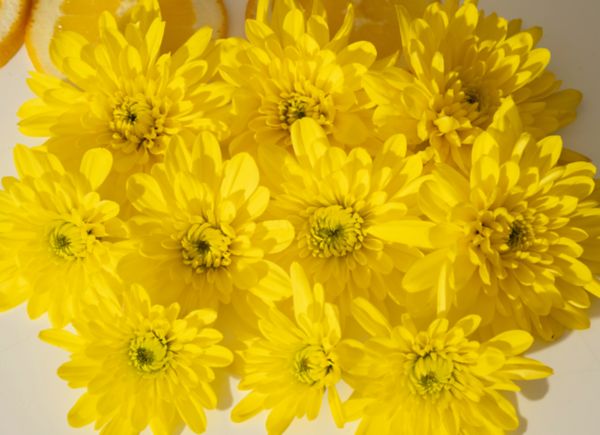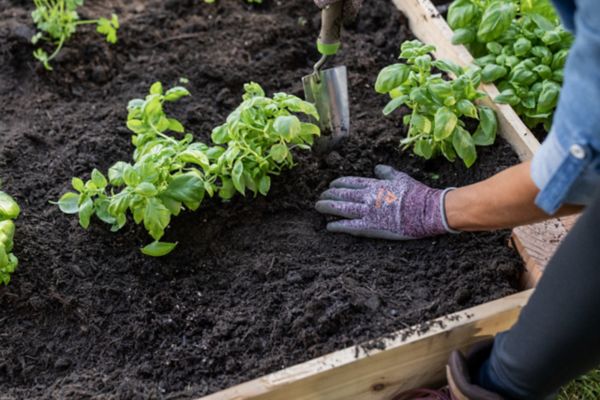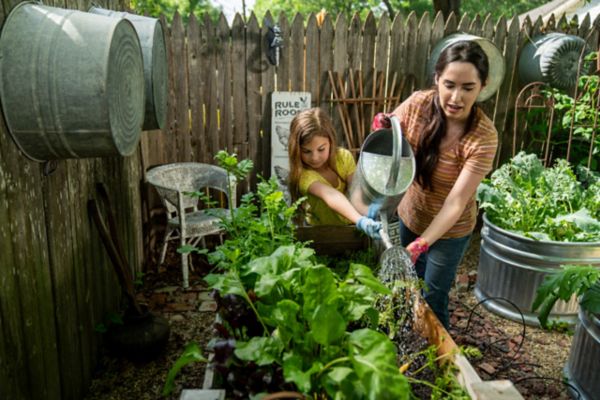How to Grow Kale
Authored by Leah Chester-Davis
When you grow the dark green, leafy vegetable known as kale, you will have a nutrition superstar at your fingertips. Kale is a superfood, delivering a healthy dose of vitamins K, A, and C, beta-carotene, lutein, glucosinolates, and other healthy compounds that can help reduce a wide range of health risks, including cancer. The bonus is that this nutrition powerhouse is easy to grow and is quite tasty.
Kale is in the same family as cabbage, broccoli, cauliflower, and Brussels sprouts. It is the leafy form of the species, producing large, thick leaves. Depending on the type, the leaves may be curly, ruffled, or lobed on the edges and varying shades of green, red, or purple. Kale thrives when the temperatures are cooler. It is on the list of the earliest plants for the spring garden and returns to the fall garden list. It is popular for edible landscaping.
About kale
| Botanical name: | Brassica oleracea (Acephala Group) |
| Common name: | Kale |
| Plant type: | Biennial grown as an annual |
| Size: | 1 to 1 ½ feet by 1 to 1 ½ feet |
| Sun exposure: | Full sun |
| Soil type: | Wide range if well drained with high organic matter |
| Soil pH: | 6.0 to 7.5 |
| Hardiness zones: | 2 to 11 |
| Average first frost: | Varies by region |
| Average last frost: | Varies by region |
| Container friendly: | Yes |
| Beginner friendly: | Yes |
Growing
Give kale a spot in organically rich, well-drained soil in the full sun, at least 6 hours per day. The soil pH should be in the 6.0 to 7.5 range. It is helpful to get the soil tested every few years, which helps figure out whether any amendments need to be added. Soil test kits are available from county Extension offices for free or nominal fees. Follow the guidelines. An inch of well-rotted manure or compost added to the garden in the spring or fall likely will reduce the need for other fertilizer applications.
This cool-season vegetable, which is popular in both spring and fall gardens, will not do well when the temperatures consistently rise above 80 degrees F. Take that into consideration when planning your planting times and plant early enough in the spring so you can enjoy this green before the weather turns hot.
Types of kale
There are several varieties of kale. A few popular ones:
Dazzling Blue
‘Dazzling Blue’ has blue-green leaves with bold purple midribs.
Oldenbor
‘Oldenbor’ has a tight curl on its leaves and is a fusarium yellows-resistant variety.
Prizm F1
‘Prizm F1’ is an All-America Selections Winner that is prized for its tight ruffled-edge leaves, almost stemless stalks, and flavorful leaves.
Lacinato
‘Lacinato’, sometimes called Tuscan or dinosaur kale, is blue gray with narrow, pucker-like, textured leaves that grow upright. It is a popular culinary kale.
Redbor
‘Redbor’ has deep maroon or purple ruffled leaves. Use it in salads or stir fries. This edible kale adds a dramatic contrast in containers with Tuscan kale and pansies.
Vates Blue Curled
‘Vates Blue Curled’ has blue-green, ruffled leaves and is popular in colder climates.
Winterbor
‘Winterbor’ has bright green, curly leaves that turn a bluish hue as they age.
Kale Garden Blends
Kale Garden Blends often include varieties that will be purple, green, and blue, giving you a chance to try a medley.
Inquire at your garden center or county Extension office for best varieties for your region. Any of them serve double duty as an ornamental with pansies and other cool-season annuals.
Planting
Kale can be started from seeds indoors or directly seeded into the garden as soon as the soil can be worked in the spring, likely anywhere from two to four weeks before the last frost date. To decide the date to plant in the fall, check the maturity date and add 14 days (about 2 weeks). That is how many days you need to plant before the projected first fall frost date. Or just plan on planting 6 weeks (about 1 and a half months) before the first fall frost date to enjoy a fall and early winter harvest. Kale can withstand heavy frosts in the spring and fall. In fact, frost is a friend to kale. It enhances kale’s flavor by increasing the sugar content.
Kale seeds are small, so plant them ¼ to ½ inch deep and about an inch apart in rows that are 24 to 36 inches apart. Lightly cover with soil. When the plants have four true leaves, thin them (but don’t discard) to about 12 inches apart to give each plant plenty of space to grow. The amount of space between plants depends on your preferences. If you plan to allow the plant to grow to maturity, plant 12 to 24 inches apart in the row. But if you wish to harvest repeatedly as the plant grows, planting about 4 inches apart may be adequate to harvest it at the baby stage. Keep in mind that the more room you give the plant, the larger it can grow. Transplant the removed seedlings to a space in the garden where they have room to grow. If you have transplants that you have started or bought, plant them outside when they are 3 to 5 weeks old.
After planting, mulch with a 2-inch layer of straw to help suppress weed growth and keep moisture levels even. Cut off any weeds at the soil or just below soil level, being careful not to damage plants. The days to maturity ranges from 40 to 80 days (about 2 and a half months), depending on the variety.
Kale will be at its most flavorful if it has received adequate water, about an inch of water per week. For best results, keep the moisture levels even.
Fertilizing
If you have applied well-rotted manure or compost and worked it into the garden before or at the time of planting, you may not need to apply fertilizer. In the absence of a soil test and if a recent application of compost has not been made, Utah State Extension recommends ½ cup per 10 feet of row of a nitrogen-based fertilizer, such as 21-0-0, about 4 weeks after transplanting or thinning. Place the fertilizer 6 inches to the side of the plants, use a hoe to scratch into the soil, and then water in.
Controlling Pests, Diseases, and Other Problems
Aphids and cabbage worms and loopers are some of the most bothersome pests. Aphids feed on the undersides of leaves; use a strong spray of water to dislodge them or an insecticidal soap. Follow label directions. Cabbage worms and loopers chew holes in the leaves. Handpick and destroy larvae. If needed, use Bacillus thuringiensis (Bt), an organic pesticide. Follow label directions. One of the best ways to reduce insect, pest, or disease problems is to implement good cultural practices such as having your soil tested and adding necessary amendments such as well-rotted manure, practicing crop rotation, controlling weed growth, and keeping plants watered to reduce stress.
Harvesting and Storing
Like most leafy greens, kale can be harvested at various points during the growth cycle. It can be considered a microgreen and cut when the leaves are tiny; when the leaves are 6 to 8 inches; or when the plant matures and the leaves are 12 or more inches long. Harvest the outer leaves at any point, leaving the inner leaves to continue to grow. If you wish, the entire plant can be harvested. Typically, it will be about 20 to 30 days (about 4 and a half weeks) until baby greens are ready and 40 to 80 days (about 2 and a half months) for mature leaves. Harvest when the leaves are a healthy dark green. As the plants mature and temperatures warm, the leaves can become tough and bitter. Discard any yellow, brown, or wilted leaves.
Harvest time may also depend on how you plan to use the green. Small, tender greens can be tossed into salads. As the greens grow, the larger, tougher leaves may be best braised lightly and then stir-fried. The large leaves are also popular for baking into kale chips. It’s possible to eat the larger leaves raw, but they likely will need to be chopped and massaged to soften them for any type of salad. This step makes a world of difference. Wash the leaves and let them dry, rough chop, add a light drizzle of olive oil, and, with clean hands, begin squeezing, pressing, and rubbing the leaves for a couple of minutes but not so long that they turn to mush. This process makes the greens more tender and easier to eat. Toss them with your favorite ingredients and a vinaigrette and you will be happy you grew this leafy green.
In many regions, kale continues to grow and can be enjoyed through the winter.
Storing
Store kale unwashed in a plastic bag for about 5 to 10 days (about 1 and a half weeks) in the refrigerator. Kale can also be frozen. A method recommended by the National Center for Home Food Preservation is to select tender leaves, wash and remove stems, blanch for 2 minutes in boiling water, cool, and drain. Package in a freezer container and freeze. The center also supplies guidelines for canning and drying greens.
Store kale unwashed in a plastic bag for about 5 to 10 days (about 1 and a half weeks) in the refrigerator.
Expert Tips
- Practice crop rotation; grow kale where you have not grown it, nor any other Cole crops the past 4 years. Other Cole crops include cabbage, cauliflower, broccoli, Brussels sprouts, collards, mustard, turnips, or rutabagas.
- A good rule of thumb is to plant about 5 plants per person, but that totally depends on you and your family. Plant more if you wish to process and freeze.
- Early maturing plants seem to have fewer problems with cabbage worms and loopers.
Frequently asked questions
Is ornamental kale edible?
It is, but it likely doesn’t have the flavor of the kales grown for culinary use.
Can I grow kale in a container?
Absolutely, in fact kale adds dramatic color, texture, and height to containers. While there are ornamental varieties, the edible types are quite lovely combined with ornamental plants, though you may end up not wanting to disrupt the beautiful appearance. Plant a container with just kale plants that you can harvest for culinary purposes.
Will kale grow if I cut off the entire plant?
No, if you remove the small leaves at the center of the plant that usually prevents it from putting on new growth. To keep your plant producing, remove outer leaves only.





